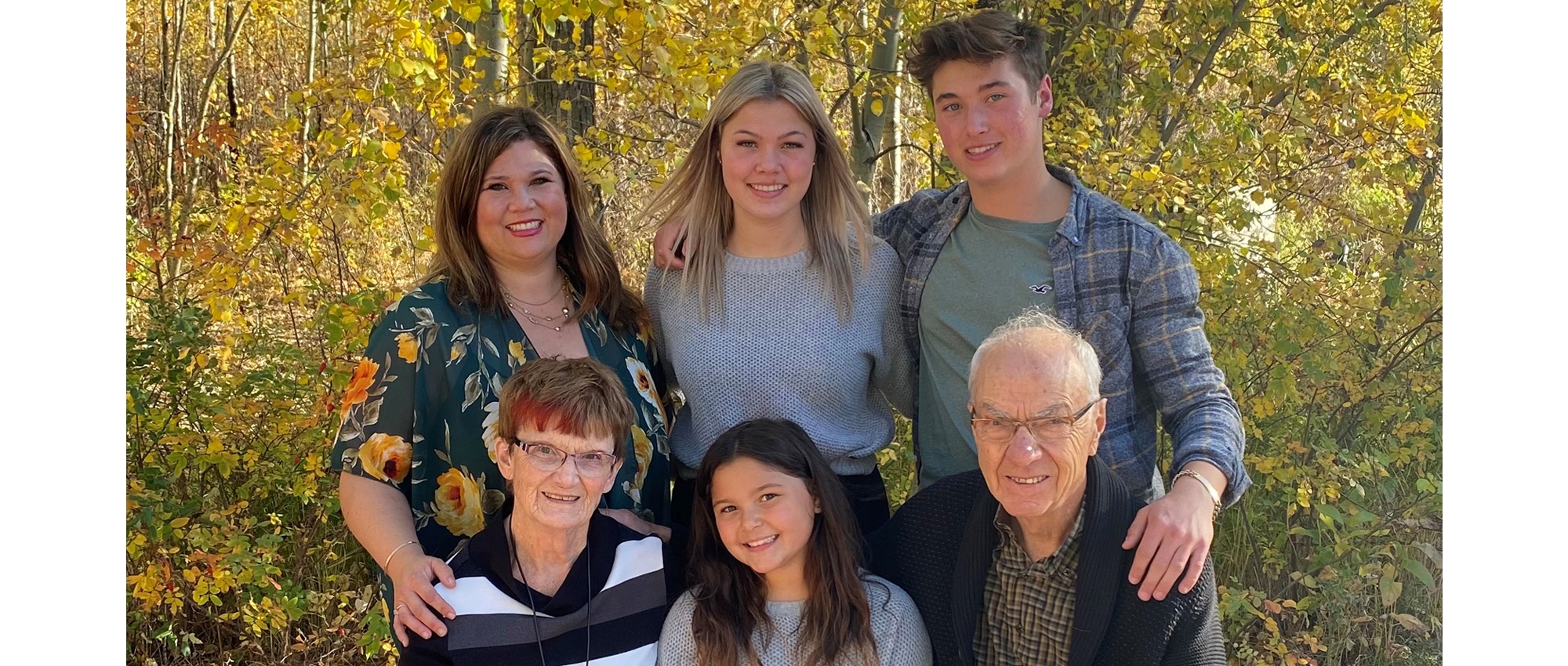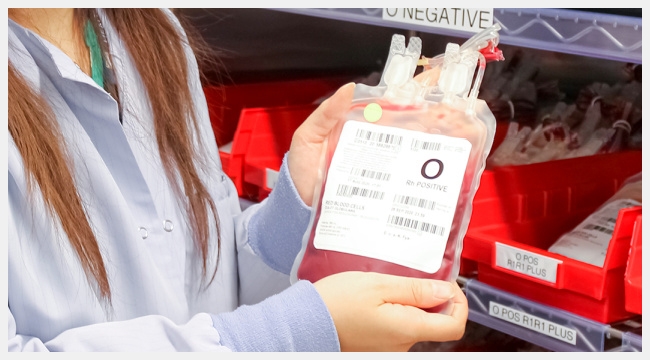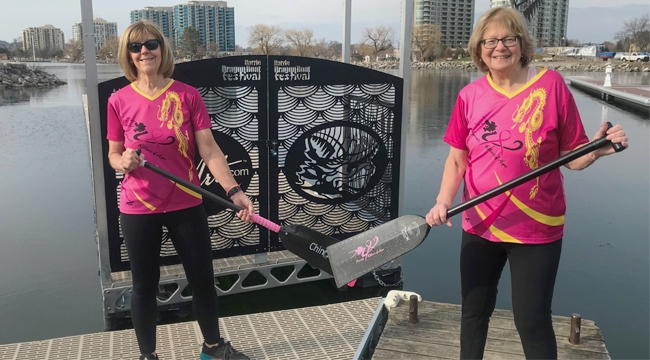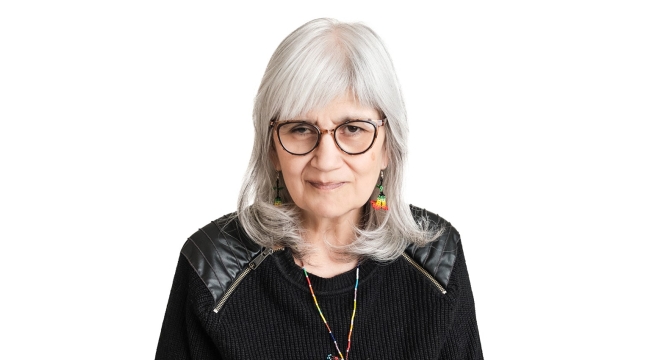Celebrating a hero
Edmonton man hailed a hero by blood recipient as he celebrates his 800th donation
The Muir family. Front row, left to right: Jean, Zoe and Allan. Back row, left to right: Sarah, Ella and Tristan. (Photo taken pre-covid-19.)
Since 2015, Edmonton’s Lorraine Wigston has faced many health challenges, including three life- threatening diseases. She is a strong advocate for blood donation and hails extended family member Allan Muir as her biggest hero. Allan, now 81, has been donating blood products for more than 50 years and just marked his 800th donation milestone.
Lorraine was a regular donor for years and, as part of the annual Edmonton Corporate Challenge, helped coordinate group blood donations for EPCOR. She never suspected that one day she herself would be relying on blood products to survive.
“My original health problems started in October 2015, when discovery of a lump led to a diagnosis of neck cancer,” says Lorraine. Since that original diagnosis, she has faced two other life-threatening diseases.
“I had just finished 30 rounds of radiation for my neck cancer in 2016 when I started having some vision issues that I had never experienced before. I also had numerous small bruises on my body that I thought were related to my cancer or perhaps the treatments.”
Consultation with an oncologist, an optometrist and other specialists revealed hemorrhages in her eyes, among other symptoms. After a 25-day stay in hospital, Lorraine was diagnosed with scleroderma, a rare group of diseases that cause hardening and tightening of the skin and connective tissues, as well as thrombotic thrombocytopenic purpura (TTP), a rare blood disorder in which blood clots form in small blood vessels throughout the body.
The clots caused by TTP can limit or block the flow of oxygen-rich blood to the body's organs, such as the brain, kidneys and heart, resulting in serious health problems or even death if left untreated.
Need for plasma
Lorraine feels fortunate that her TTP was diagnosed as quickly as it was, since that allowed appropriate treatment to begin promptly.
The first line of treatment for TTP is plasmapheresis, where a machine is used to remove the affected plasma and replace it with good plasma or a plasma substitute. This process is also known as plasma exchange.
“My blood is monitored every month to six weeks, or sooner if symptoms indicate a possible relapse. A relapse can be triggered by simply getting the flu or some other virus.”
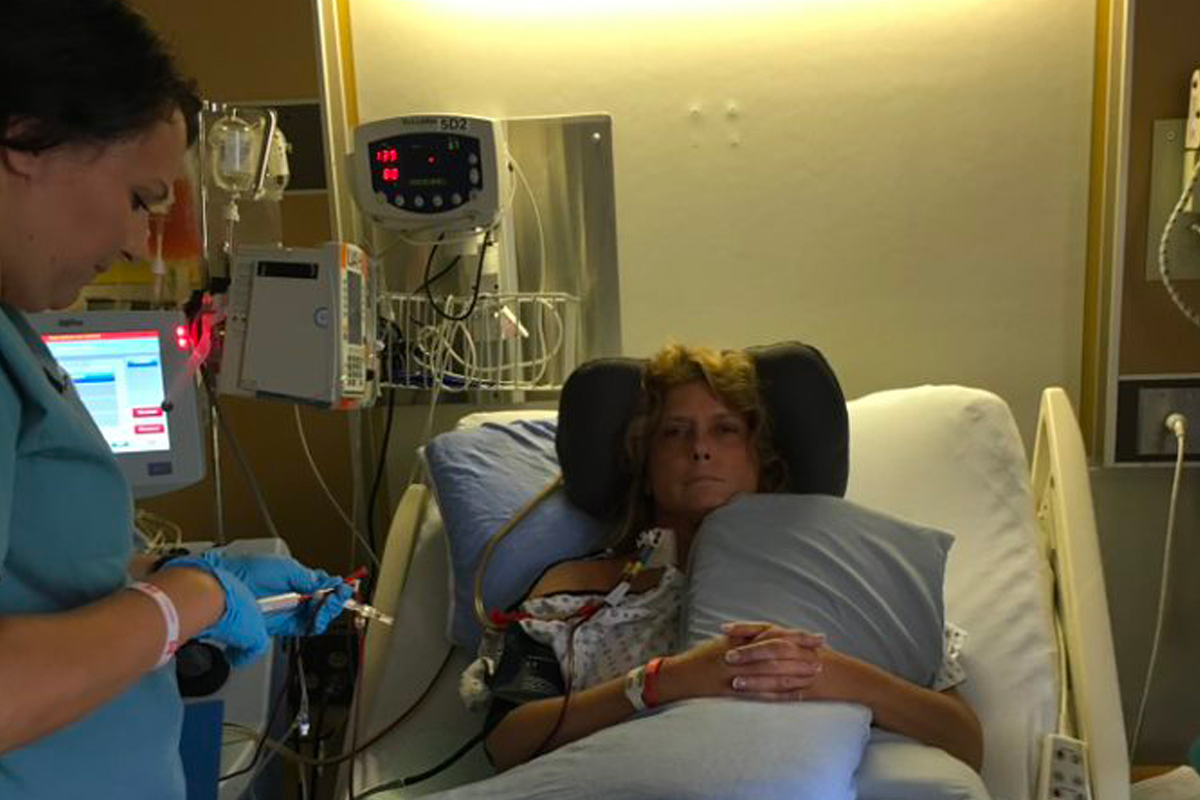
Lorraine during a treatment.
Lorraine has been hospitalized twice since her original diagnosis with TTP. Most recently, in January 2021, she needed in-hospital care after tragically contracting COVID -19 from her dying father.
During Lorraine’s hospital stays, she has needed plasma transfusions. “I believe I have received over 500 units of plasma since my diagnosis with TTP, thanks to the generosity of donors like Allan Muir.”
“I can do that”
Allan Muir is a quiet man with a big heart. This Edmonton-area native has been happily married to his wife, Jean, for 57 years. The couple have a daughter, Sarah, and three grandchildren, Ella, Tristan and Zoe. Lorraine has been a member of his extended family for more than 35 years through her marriage to a cousin of Jean’s.
Allan has always been a person who likes to help others. When he was 18, he heard that blood donors were needed and thought, “I can do that!” And so began a lifetime of donations.
Allan, now 81 years old, remains in good health and has been donating blood products for well over half his lifetime.
His donation history includes about nine years of giving whole blood, three years of giving platelets and an amazing 36 years of donating plasma.
“I was a large-volume platelet donor (approximately five times) for a young boy with cancer,” he proudly recalls. “But eventually I found donating platelets to be too hard on my arms, as they both had to be extended for around two hours or so.”
Since 1985, Allan has been a weekly plasma donor, often booking his appointments a year in advance.
Most Wednesday evenings, he can be found at Canadian Blood Services’ Edmonton donor centre at 6:10 p.m., his regular appointment time.
Allan has gotten to know a lot of the staff and other regular donors over the years and has seen changes in many things, from the screening process to the spacing of donor beds.
“It’s kind of neat to see the same people every week — to say hi, check in, or even exchange a recipe or two.”
“I do it because it’s the right thing to do, and I look forward to donating every Wednesday. People often say, ‘Is it ever great that you do that.’ But when I ask if they want to come with me, they say, ‘No, thank you, I’m busy.’”
When asked about reaching his recent milestone, Allan replied, “I never really had a plan or a goal until I realized I was nearing the 800 mark, then decided to go for it!”
Allan made his 800th donation in March. Lorraine and a few family members joined him to celebrate.
“It’s a huge milestone, and it was important to be with him to recognize it and to congratulate and thank him,” says Lorraine. “I knew that, due to current COVID-19 restrictions, I wouldn’t be able to go into the donor centre, but I wanted to get a photo with him, promote his amazing accomplishment on social media and help encourage people to donate blood and blood products.”
Humble hero
Allan Muir is a hero in Lorraine’s eyes.
“It’s people like Allan who generously provide the plasma that I receive in the hospital. It’s great to know him personally, and I am eternally grateful to him and anyone who donates plasma. I know that I would be dead if it weren’t for people like Allan.”
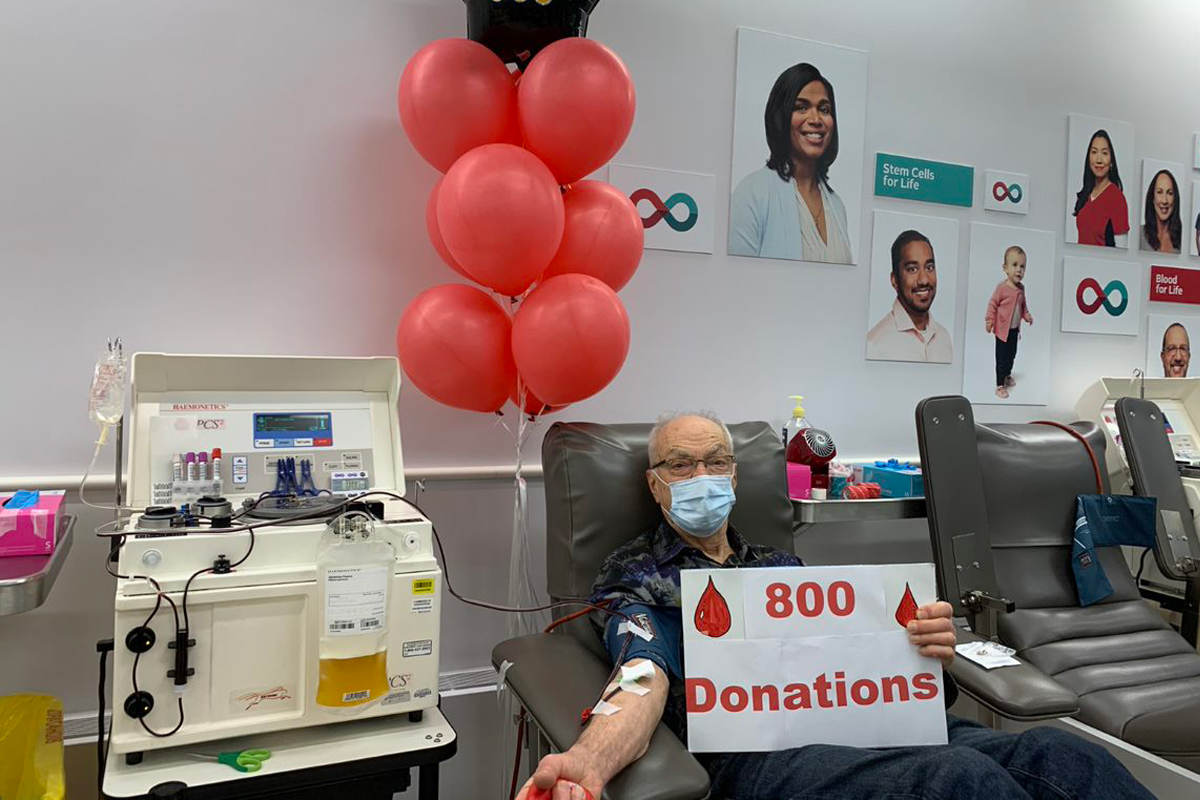
Allan making his 800th donation.
When asked how he felt to be called a “hero,” Allan humbly replied, “It brought tears to my eyes. It was not my plan to be a hero. It started as something to give back to the community. If someone needs a blood donation — why wouldn’t I give it?”
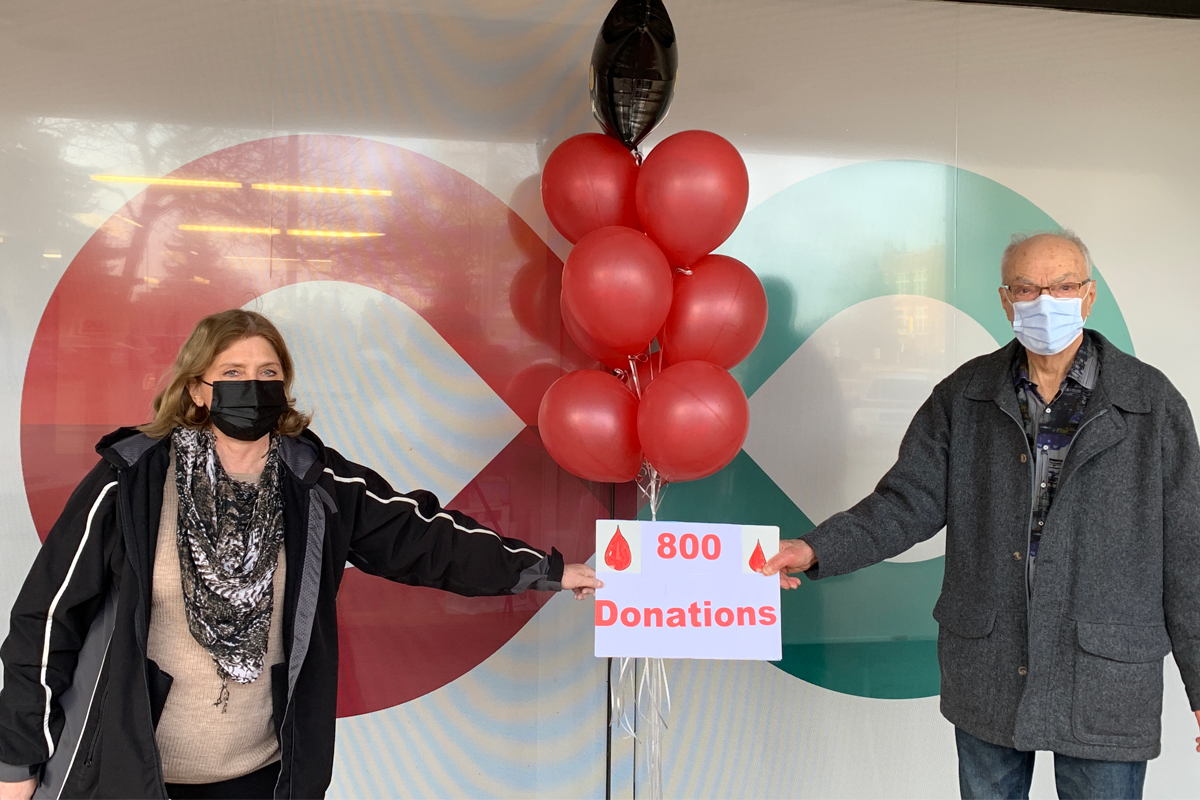
Lorraine and Allan celebrate Allan’s 800th donation.
Lorraine and Allan are both passionate advocates for blood donation.
Allan plans to donate for as long as he is able and encourages others to get involved. “Go for it — it doesn’t hurt! And it is just a little time out of your day once a week.”
As for Lorraine, she says, “There are no words that can express the gratitude that I feel toward the people who donate blood products of any kind. Although you [as a donor] may never meet them, there are so many people who are truly grateful for your donation, because without it, they would not survive.”
Using other gifts to help save lives
From an early age, Allan had a passion for mechanics gained from spending time with his favourite uncle. His interest and natural ability led him to become a journeyman machinist, and he went on to enjoy a 30-year career at the University of Alberta as a machinist in the civil and mechanical engineering departments.
The work was both interesting and challenging. When creating equipment needed for doctoral research, for example, he often “worked with grad students to build from [their] concepts and rough drawings written on paper towel.”
After a long and rewarding career, Allan is still making important contributions.
Three months into his retirement, Allan was contacted by a biomedical engineer working on a project to extract islet cells from donor pancreases for diabetes research. He seized the opportunity to use his gifts to help save lives in another way.
“I felt honoured to be approached by a biomedical engineer to assist in further developing the small laboratory machines required to carry out the research,” says Allan.
After training with experts in the field, Allan became familiar with blood cell separators and eventually formed a home-based business called Argyll Innovations Inc.
Since 2010, he has travelled to various cities in the United States and overseas to modify blood cell separators for use in diabetes research. He’s also responsible for maintaining the modified blood cell separating machines used in Alberta Health Services’ clinical islet laboratory.
The job has also taken him to Switzerland, Sweden and Italy, always with Jean at his side.
“I say to her, ‘You know, I’m going to be in the lab [working on the machines], and if you want to go shopping or sightseeing, go ahead.’ And she says, ‘No, we’ll do it together.’ And we can do it way faster with two people. So, we’re down on our knees at the machine, and she’s on one side and I’m on the other side.”
A fortunate man
Allan has a positive outlook on life.
“I feel very fortunate at my age to still be able to donate plasma and be part of the islet program, as well as being able to manufacture intricate pieces of medical equipment for research purposes.”
According to Allan, “Retirement is not just enjoying life — you must keep busy.”
